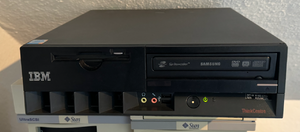SCO Openserver 5.0.7 installation: Unterschied zwischen den Versionen
Luna (Diskussion | Beiträge) (Die Seite wurde neu angelegt: „== Openserver == SCO started in 1983 with a XENIX port to the IBM PC/XT. They later acquired XENIX from Microsoft completely. In 1989 they released the first…“) |
Luna (Diskussion | Beiträge) Keine Bearbeitungszusammenfassung |
||
| Zeile 1: | Zeile 1: | ||
== Openserver == | == Openserver == | ||
SCO started in 1983 with a XENIX port to the IBM PC/XT. They later acquired XENIX from Microsoft completely. In 1989 they released the first version of a new SVR3 port called "SCO UNIX System V Release 3.2". It replaced XENIX as SCO's main product and went through a number of iteration. The last versions of this line of Unix system was called "Openserver 5". It is basically a classic SVR3 Unix system with added quality of life improvements and support for more-of-less recent hardware. | SCO started in 1983 with a XENIX port to the IBM PC/XT. They later acquired XENIX from Microsoft completely. In 1989 they released the first version of a new SVR3 port called "SCO UNIX System V Release 3.2". It replaced XENIX as SCO's main product and went through a number of iteration. The last versions of this line of Unix system was called "Openserver 5". It is basically a classic SVR3 Unix system with added quality of life improvements and support for more-of-less recent hardware. One interesting aspect of Openserver is that SCO has build in XENIX compatibility. | ||
'''Installing Openserver 5.0.7 on a PC''' | '''Installing Openserver 5.0.7 on a PC''' | ||
[[Datei:Ibm_thinkcentre.png |thumb|right|IBM Thinkcentre S50]] | |||
We will be installing SCO Openserver on this lovely little IBM Thinkcentre S50 PC. It has a 3GHz Pentium 4, 2GB of RAM, 80GB of IDE disk, and Intel 865G chipset graphics. There is also an Intel Pro/100 ethernet chip onboard, but I could not get this working in Openserver. Fortunately, IBM design two normal height PCI slots into this little machine, so I just added a 3com 905B PC ethernet card. | |||
[[Kategorie: UNIX]] | [[Kategorie: UNIX]] | ||
[[Kategorie: SCO]] | [[Kategorie: SCO]] | ||
Version vom 6. Oktober 2023, 21:47 Uhr
Openserver
SCO started in 1983 with a XENIX port to the IBM PC/XT. They later acquired XENIX from Microsoft completely. In 1989 they released the first version of a new SVR3 port called "SCO UNIX System V Release 3.2". It replaced XENIX as SCO's main product and went through a number of iteration. The last versions of this line of Unix system was called "Openserver 5". It is basically a classic SVR3 Unix system with added quality of life improvements and support for more-of-less recent hardware. One interesting aspect of Openserver is that SCO has build in XENIX compatibility.
Installing Openserver 5.0.7 on a PC
We will be installing SCO Openserver on this lovely little IBM Thinkcentre S50 PC. It has a 3GHz Pentium 4, 2GB of RAM, 80GB of IDE disk, and Intel 865G chipset graphics. There is also an Intel Pro/100 ethernet chip onboard, but I could not get this working in Openserver. Fortunately, IBM design two normal height PCI slots into this little machine, so I just added a 3com 905B PC ethernet card.
